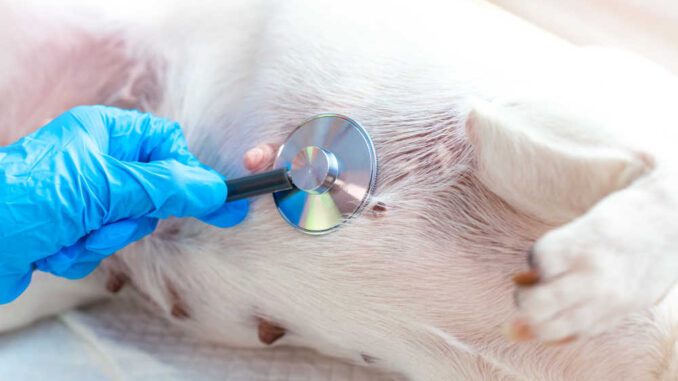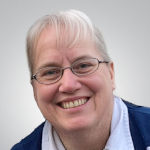
This article was updated on January 20th, 2024
When I worked as a veterinarian in practice, I got a few visits from clients about bleeding nipples on their dogs. Some were caused by injuries, but others pointed to infections or cancer. To help you know how to handle it, I’ll explain the possible causes and symptoms, share a few home care tips, and help you understand when it’s time to call your veterinarian.
“Bleeding nipples are not normal – they are often an indication of an abnormal condition like injury, infection, or a tumor.”
Common reasons for bleeding nipples in dogs
Nipples and the underlying mammary tissue have an extensive supply of blood vessels and capillaries. When the integrity of the blood supply is compromised, you may see bleeding from the nipples. The major causes of this condition include injury/trauma, infection, or tumors:
1. Injury or trauma
The nipples or mammary glands are susceptible to injury. Causes of trauma may include
- Rough play with other dogs that includes scratching or biting
- Dog fights
- Aggressively nursing puppies that scratch or bite the nipples/abdomen
- Accidents such as car crashes that cause trauma
- Damage from surgery
- A foreign body such as a twig or thorn
See this picture of a bleeding nipple due to trauma. If a traumatic event causes blood vessels in the nipple or mammary gland to rupture, blood can leak into the canal and leak from the teat. When this happens, there may be blood pooling in the gland. Other signs can include:
- local swelling and warmth – may indicate a secondary infection or abscess
- discomfort.
Try applying warm compresses to ease inflammation and pain. Monitor your and contact your vet if you notice signs of fever or behavioral changes such as loss of appetite or lethargy. Depending on the severity of the injury and whether there’s an infection, the doctor may prescribe painkillers, anti-inflammatory drugs, and antibiotics.
2. Infections
Mammary abscesses or mastitis can disrupt the blood supply and cause bleeding from the nipples.

Signs of an infection include:
- Yellow or bloody discharge
- Swollen mammary glands
- hot/painful mammary glands
- Reluctance to allow nursing
- Fever
- Lethargy
If you see signs of mastitis or infection in your dog’s mammary gland, take her to the vet. Some forms of mastitis can be life-threatening. Your veterinarian can take samples for culture and flush the gland. Depending on the severity of the infection, he may administer oral or IV antibiotics and anti-inflammatory medications. Learn more about mastitis.
3. Mammary gland tumor
Male or female dogs can develop benign or cancerous tumors in the mammary tissue, but the condition is most common in unspayed females. About 50% of the masses are benign while the rest are cancerous. Benign tumors usually present as small, firm nodules.
Signs of mammary cancer include:
- Bleeding or discharge from one or more nipples
- Visible/pronounced, firm lumps or growths in the mammary tissue

- Swelling and redness around the nipple
- Painful abdomen
- Discoloration
- Lethargy
- Sudden, unexplained weight loss
“If you find lumps in your dog’s mammary glands, schedule an exam with your veterinarian. Early diagnosis and treatment help to improve the prognosis.”
Treatment includes surgical removal of the mass and affected tissue. If your female is intact, your vet will also recommend spaying. If the tumor has spread to other areas of the body, your dog will need radiation treatment or chemotherapy.
Share any of these other symptoms with your vet
The symptoms of bleeding nipples will depend on the underlying cause. Other signs to monitor and share with your vet include:
- Bright red(fresh) or dark brown(dried) blood
- Scabs on the nipples or crusting
- Swelling or lumps
- Redness and pain
- Lethargy
- Resistance to nursing
- Unexplained, sudden weight loss
- Other signs of illness or discomfort
Clean the area & monitor for signs of infections or lumps
If you notice your dog’s nipple is bleeding or has a bloody discharge, clean and observe the area for signs of trauma, infection, or lumps. If you see signs of infection or tumors, schedule an appointment with your veterinarian. Dogs with minor injuries can often be treated at home.
To care for your dog’s nipples at home:
- Gently clean the nipples and check them for signs of infection every day
- Use a warm compress to ease pain and inflammation
- If your dog is nursing, cover her abdomen with a t-shirt between feeding times to protect the nipples
- Persuade puppies to nurse from healthy, non-injured nipples
- Apply ointment as instructed by your veterinarian
When is it ok to wait-&-see at home (with basic home care)?
When your dog has bleeding nipple(s) or a bloody discharge but no symptoms of tumors or infection, you can apply some basic home care. Observe your dog daily for any changes in signs, behavior, or attitude. If your pup becomes lethargic, starts losing weight, or has other concerning symptoms, contact your veterinarian immediately.
What will happen at the vet, and how much will it cost?
When you take your dog to the vet for a bleeding nipple, he will ask you when you observed the condition and if you have noticed other symptoms. Then, he’ll examine your furbaby by checking her vital signs and observing the discharge and affected gland/nipple. If needed, the doctor will take diagnostic tests including bloodwork, ultrasound, or x-rays.
- The cost of the office visit and exam is approximately $50-150 depending on your location
- Bloodwork may cost about $100-200
- X-rays can run $40-200
- The cost of ultrasound is about $250-350
Depending on the diagnosis, treatment may include:
- Antiinflammatory drugs and pain medications for injuries – cost is approximately $50-100
- IV or oral antibiotics for infections – total cost of diagnosis and treatment can run $300-800
- Surgical removal of growths and possible radiation or chemotherapy for mammary tumors can run $2000 or more.
Frequently asked questions
My dog’s nipple is bleeding after nursing her puppies. Is this normal?
Nursing bitches may have bleeding nipples if the puppies are aggressively suckling or guarding nipples. The condition is fairly common, but it indicates injury to the gland/nipple. Take measures to protect the nipple and encourage puppies to avoid the teat while it heals.
Are certain breeds more prone to bleeding nipples?
Breeds are equally prone to bleeding nipples caused by an injury or infection. However, some breeds are more predisposed to develop mammary cancer, which can cause nipple bleeding. At-risk breeds include:
- Cocker spaniels
- Maltese
- Poodles
- Shih Tzus
- Yorkshire terriers
Can infections be transmitted from dogs with bleeding nipples to other dogs?
Mammary gland infections that cause bleeding nipples are not known to be transmissible to other dogs. If you have a nursing bitch with a bleeding nipple, the puppies can still nurse. However, you should monitor the puppies to make sure they are getting enough milk.
Can I still spay my dog if she has bleeding nipples?
Spaying is usually part of the treatment regimen for dogs with mammary cancer. As long as your dog’s bleeding nipples aren’t a sign of an infection, you should be able to spay her. When your girl has mastitis, treat the infection before pursuing surgery to prevent more severe illness.
How long does it take for a dog’s bleeding nipple to heal?
Injuries usually heal in a week to 10 days.
Infections/mastitis will usually heal in 2-3 weeks.
When nipple bleeding is caused by mammary tumors, dogs recover from surgery in 2 weeks or more depending on the stage and severity of the cancer.
Disclaimer: This website's content is not a substitute for veterinary care. Always consult with your veterinarian for healthcare decisions. Read More.


Be the first to comment